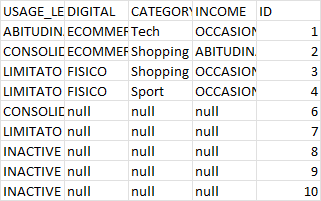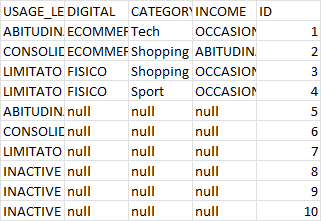Short answer
It depends on whether the JOIN type is INNER or OUTER.
For INNER JOIN the answer is yes since an INNER JOIN statement can be rewritten as a CROSS JOIN with a WHERE clause matching the same condition you used in the ON clause of the INNER JOIN query.
However, this only applies to INNER JOIN, not for OUTER JOIN.
Long answer
Considering we have the following post and post_comment tables:
![The post and post_comment tables]()
The post has the following records:
| id | title |
|----|-----------|
| 1 | Java |
| 2 | Hibernate |
| 3 | JPA |
and the post_comment has the following three rows:
| id | review | post_id |
|----|-----------|---------|
| 1 | Good | 1 |
| 2 | Excellent | 1 |
| 3 | Awesome | 2 |
SQL INNER JOIN
The SQL JOIN clause allows you to associate rows that belong to different tables. For instance, a CROSS JOIN will create a Cartesian Product containing all possible combinations of rows between the two joining tables.
While the CROSS JOIN is useful in certain scenarios, most of the time, you want to join tables based on a specific condition. And, that's where INNER JOIN comes into play.
The SQL INNER JOIN allows us to filter the Cartesian Product of joining two tables based on a condition that is specified via the ON clause.
SQL INNER JOIN - ON "always true" condition
If you provide an "always true" condition, the INNER JOIN will not filter the joined records, and the result set will contain the Cartesian Product of the two joining tables.
For instance, if we execute the following SQL INNER JOIN query:
SELECT
p.id AS "p.id",
pc.id AS "pc.id"
FROM post p
INNER JOIN post_comment pc ON 1 = 1
We will get all combinations of post and post_comment records:
| p.id | pc.id |
|---------|------------|
| 1 | 1 |
| 1 | 2 |
| 1 | 3 |
| 2 | 1 |
| 2 | 2 |
| 2 | 3 |
| 3 | 1 |
| 3 | 2 |
| 3 | 3 |
So, if the ON clause condition is "always true", the INNER JOIN is simply equivalent to a CROSS JOIN query:
SELECT
p.id AS "p.id",
pc.id AS "pc.id"
FROM post p
CROSS JOIN post_comment
WHERE 1 = 1
ORDER BY p.id, pc.id
SQL INNER JOIN - ON "always false" condition
On the other hand, if the ON clause condition is "always false", then all the joined records are going to be filtered out and the result set will be empty.
So, if we execute the following SQL INNER JOIN query:
SELECT
p.id AS "p.id",
pc.id AS "pc.id"
FROM post p
INNER JOIN post_comment pc ON 1 = 0
ORDER BY p.id, pc.id
We won't get any result back:
| p.id | pc.id |
|---------|------------|
That's because the query above is equivalent to the following CROSS JOIN query:
SELECT
p.id AS "p.id",
pc.id AS "pc.id"
FROM post p
CROSS JOIN post_comment
WHERE 1 = 0
ORDER BY p.id, pc.id
SQL INNER JOIN - ON clause using the Foreign Key and Primary Key columns
The most common ON clause condition is the one that matches the Foreign Key column in the child table with the Primary Key column in the parent table, as illustrated by the following query:
SELECT
p.id AS "p.id",
pc.post_id AS "pc.post_id",
pc.id AS "pc.id",
p.title AS "p.title",
pc.review AS "pc.review"
FROM post p
INNER JOIN post_comment pc ON pc.post_id = p.id
ORDER BY p.id, pc.id
When executing the above SQL INNER JOIN query, we get the following result set:
| p.id | pc.post_id | pc.id | p.title | pc.review |
|---------|------------|------------|------------|-----------|
| 1 | 1 | 1 | Java | Good |
| 1 | 1 | 2 | Java | Excellent |
| 2 | 2 | 3 | Hibernate | Awesome |
So, only the records that match the ON clause condition are included in the query result set. In our case, the result set contains all the post along with their post_comment records. The post rows that have no associated post_comment are excluded since they can not satisfy the ON Clause condition.
Again, the above SQL INNER JOIN query is equivalent to the following CROSS JOIN query:
SELECT
p.id AS "p.id",
pc.post_id AS "pc.post_id",
pc.id AS "pc.id",
p.title AS "p.title",
pc.review AS "pc.review"
FROM post p, post_comment pc
WHERE pc.post_id = p.id
The non-struck rows are the ones that satisfy the WHERE clause, and only these records are going to be included in the result set. That's the best way to visualize how the INNER JOIN clause works.
| p.id | pc.post_id | pc.id | p.title | pc.review |
|------|------------|-------|-----------|-----------|
| 1 | 1 | 1 | Java | Good |
| 1 | 1 | 2 | Java | Excellent |
| 1 | 2 | 3 | Java | Awesome |
| 2 | 1 | 1 | Hibernate | Good |
| 2 | 1 | 2 | Hibernate | Excellent |
| 2 | 2 | 3 | Hibernate | Awesome |
| 3 | 1 | 1 | JPA | Good |
| 3 | 1 | 2 | JPA | Excellent |
| 3 | 2 | 3 | JPA | Awesome |
Conclusion
An INNER JOIN statement can be rewritten as a CROSS JOIN with a WHERE clause matching the same condition you used in the ON clause of the INNER JOIN query.
Not that this only applies to INNER JOIN, not for OUTER JOIN.



